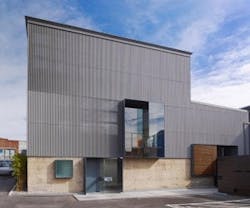The Top 10 Green Buildings for 2010 are Announced
The American Institute of Architects and its Committee on the Environment (COTE) selected the top 10 examples of sustainable architecture and green design that protect and enhance the environment.
The COTE Top Ten Green Projects follow …
355 11th Street – Matarozzi/Pelsinger Building, San Francisco
Aidlin Darling Design
355 11th Street is a LEED-NC Gold adaptive reuse of a previously derelict, turn-of the-century industrial building. The San Francisco Planning Department mandated that the project’s new siding be an “in-kind” replacement of the original (unsalvageable) corrugated metal siding, and that the overall window area be consistent between old and new. The design team successfully championed a strategy of introducing subtle perforations into the new zinc cladding to allow light and air into the occupied spaces beyond, maintaining the stoic character of the original building without the visual introduction of new fenestration.
City of Watsonville Water Resources Center, Watsonville, CA
WRNS Studio
The 16,000-square-foot building consolidates three city and county water departments into a workspace that allows thoughtful and continuous collaboration on water management, conservation, and quality in the Pajaro Valley. The facility includes administrative offices, a water quality lab, educational space, and a design that puts the story of water in California on display.
KAUST, Thuwal, Kingdom of Saudi Arabia
HOK
King Abdullah University of Science and Technology (KAUST) is an international, graduate-level research university established to drive innovation in science and technology, and to support world-class research in areas such as energy and the environment. KAUST’s new campus is the Kingdom of Saudi Arabia’s first LEED-certified project, and the world’s largest LEED Platinum project.
Kroon Hall, Yale University, New Haven, CT
Hopkins Architects and Centerbrook Architects & Planners
Replacing a brownfield site, Kroon Hall was charged with being a net-zero-energy building. Kroon Hall sets a new standard for schools around the country. It had to function not simply as a sustainable overlay that offset unsustainable practices in people’s everyday lives, but also as something that inspired and encouraged people to alter their lives and become more sustainable citizens.
Manassas Park Elementary School + Pre-K, Manassas Park, VA
VMDO Architects PC
MPES is fundamentally designed around the premise that people, especially children, can’t be expected to preserve or protect something they don’t understand. As such, the school is conceived throughout as a teaching tool that shepherds children along a path of environmental stewardship. Inside and out, sustainable design is integrated with the elementary curriculum. Design decisions were made with the expressed goal of showcasing as many teachable moments as possible. Interior extended learning spaces offer dramatic and surprisingly intimate views of the neighboring mixed oak forest, while elementary classrooms face shady moss and fern-covered learning courtyards.
Manitoba Hydro Place, Winnipeg, MB
Kuwabara Payne McKenna Blumberg Architects and Smith Carter Architects and Engineers
Manitoba Hydro Place was designed utilizing a formal integrated design process to achieve daunting goals of energy efficiency, healthy workplace environment, urban revitalization, sustainability, and architectural excellence. This building is a model for bioclimatic design in an extreme climate that fluctuates by 70 degrees C. annually. It’s the most energy-efficient large office tower in North America, with a 66-percent improvement over the standard.
Michael J. Homer Science & Student Life Center, Atherton, CA
Leddy Maytum Stacy Architects
The 44,109-square-foot building incorporates an unusual hybrid program of eight sophisticated science classrooms, a 700-seat auditorium, a 350-seat dining hall with full commercial kitchen, and administrative offices in spaces that inspire scientific inquiry, foster a strong learning community, and promote environmental stewardship. The design encourages scientific inquiry, linking the school’s science curriculum to building functions throughout the seasons – how it breathes, resists gravity, conserves precious resources, and generates energy.
Omega Center for Sustainable Living, Rhinebeck, NY
BNIM Architects
The Omega Center for Sustainable Living (OCSL) is a very purposeful building and site, designed to clean water, return the clean water to the local systems, and educate users about the process. The entire building and water process utilize site harvested renewable energy achieving a net-zero-energy system. This required the facility to be free of waste (volume, material, energy), organized, and carefully tuned to harvest solar energy for passive heating and lighting, utilizing the entire mass for thermal comfort. The resultant design’s simplicity and elegance fit its noble purpose.
Special No. 9 House, New Orleans
KieranTimberlake
The Special No. 9 House was designed for the Make It Right Foundation to provide storm-resistant, affordable, and sustainable housing options for the residents of New Orleans’ Lower Ninth Ward displaced by Hurricane Katrina. To support Make It Right’s goal of building 150 homes in the Lower Ninth Ward, this single-family home is poised for mass production, anticipating a shift from on-site to off-site fabrication as more homes are scheduled for construction. Key goals were to create safe, healthy, and dignified housing to residents in a flood-prone area, and to empower residents to return to improved living conditions that take advantage of New Orleans’ climate and express its deep cultural heritage.
Twelve|West, Portland, OR
Zimmer Gunsul Frasca Architects LLP
Twelve|West is a mixed-use building designed with sustainability and ongoing learning as integral goals. Twelve|West was designed to achieve the highest levels of urban sustainability, and is expected to earn a Platinum rating under LEED-NC overall and LEED-CI for the office floors. An emphasis was put on selecting low-impact materials, including salvage, reclaimed, and FSC-certified wood. Much of the concrete building structure is exposed on the interior, minimizing the use of finish material and providing ample thermal mass.
